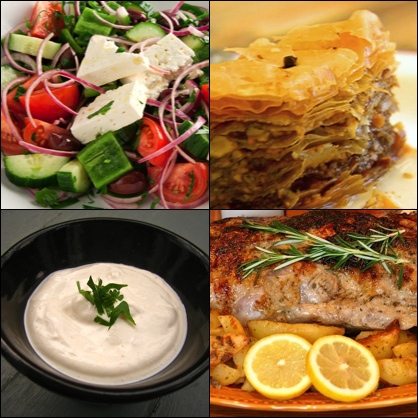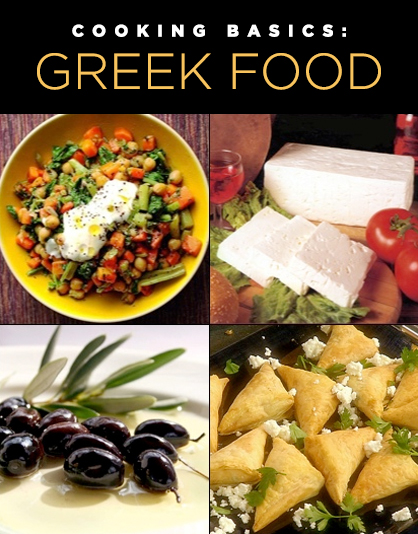Inside a Greek Kitchen: 5 Classic Ingredients and Recipes
This week, we go Greek, exploring the unique range of rich flavors of this Mediterranean nation. From kalamata olives to Greek yoghurt and filo dough, we explore some common Greek must-have ingredients. Tantalize your senses with recipes such as Rigatoni with Artichokes, Kalamata Olives and Herbs; a classic Greek salad with homemade dressing; a traditional yoghurt cucumber sauce; and Spanakopita, hot pastry triangles filled with feta cheese and spinach.
GREEK OREGANO/RIGANI
Experience the different flavors of Greek oregano over the conventional variety. Known as rigani, this herb adds authentic flavor to meat and fish, tomato sauces, egg recipes and baked vegetables such as zucchini and green beans. Grown on the mountain slopes of Greece, as well as throughout the Mediterranean, this member of the mint family gets its name from “joy of the mountain.” It is most famously used in Greek salad and added to the lemon olive-oil sauce used to roast meats or make Greek fried potatoes. Available both fresh and dried, ground leaves are thought to have more flavor so it is worth hunting down the real deal. An alternative to fresh Greek oregano are herbs such as marjoram, thyme, basil or traditional oregano. In this famous Greek Roasted Chicken, mustard, honey, garlic and lemon complement the oregano while Grilled Mushrooms with Oregano and Garlic enhance flavors of thyme, parsley and balsamic vinegar to make a sumptuous Greek side dish.
FILO PASTRY
Peeping up everywhere in famous Greek recipes, these paper-thin sheets of unleavened pastry dough can either be made from scratch or bought pre-made in the frozen foods section. Certain to impress the guests, filo dough can form the basis of sweet dessert pastries or savory appetizers such as hearty pie triangles filled with wild mushrooms or tofu and veggies. Because they can dry out easily when exposed to air, it is important to keep the sheets covered in plastic wrap or a damp cloth and keep an eye on the dough’s fragility. It is also possible to keep it frozen for up to a year, however, avoid refreezing as it will turn dry and crumbly. When preparing the filo dough, grease the triangles with butter or oil, preferably brushed on. Try the classic Greek dish Spanakopita, which stuffs filo dough with feta cheese, spinach and nutmeg, a hot appetizer idea for your next party. Finish your meal with this easy Baklava, another Greek favorite with honey, cinnamon, nuts and vanilla, or opt for an edgier dessert with this Date and Walnut Phyllo Rolls with orange peel and honey.
KALAMATA OLIVES
Named after the region it originates from, the native Greece Kalamata olive is undoubtedly the most popular olive around the world. Sometimes referred to as the “Greek olive”, this almond-shaped, deep purplish olive is left to ripen longer on the vine before it is picked. Usually brined, packed in olive oil or vinegar, kalamata olives get a rich flavor from their marinade, making them more intense than other olives. Before being brined or pickled, Kalamata olives are slit to allow the marinade to soak into the olive’s meaty inner flesh. Filled with healthy fats, this fruit is great for party platters with cheese and other grabable appetizers, thrown onto a quick salad, sprinkled over pizza or mixed into an easy tapenade. The salty flavor easily boosts a dish without any extra spice or seasoning. They perk up this Rigatoni with Artichokes, Kalamata Olives and Herbs, a beautiful pasta medley. And this Greek Potato Salad with feta cheese, kalamata olives and a fresh lemony vinaigrette will blow that potato salad you ate at your last picnic out of the water.

GREEK YOGHURT
Greek yoghurt is one of the hottest food trends on the market. Known for its thick, creamy texture, Greek yoghurt is traditionally made from sheep or goat milk strained in muslin bags until the liquid whey disappears and it turns into the consistency of sour cream. Healthy and nutrient packed, it is loaded with calcium, zinc, probiotics and vitamins B6 and B12. Another benefit of Greek yoghurt is reduced sugar and fewer carbohydrates, ain addition to twice the protein of regular yoghurt. Perfect in both sweet and savory dishes, Greek yoghurt is the base of the famed Tzatziki, a tangy yoghurt cucumber dip, and can be used as a marinade in spicy meat dishes. Or pair this tart cream with fresh fruit and a drizzle of Greek honey. Its creaminess and body makes it a good substitute for cream cheese, sour cream, buttermilk, heavy cream or ricotta cheese, especially when slightly watered down. Be careful when using it in cooking as a substitute for regular yoghurt, as it acts differently. Greek yoghurt also makes a delicious topping to salads (like this creamy Greek Yogurt Salad Dressing) with a homemade blend of shallots, garlic, lemon juice and paprika that creates a healthy alternative to the usual cream-based dressings. Craving something sweet? Use greek yogurt to accentuate Greek Tiganites, a traditional buttery pancakelike dish garnished with cinnamon and honey.
FETA CHEESE
The national cheese of Greece, feta is a staple in Greek cooking. In fact, the cheese is protected by European Union law: Only cheese manufactured in Greece may be called feta. This crumbly, brined, curd cheese is typically made from pure sheep milk, then mixed with yoghurt, salt and rennet and aged in barrels or tins. Its flavor, firmness and texture varies from mild, creamy and soft to sharp, crumbly and hard. Feta's consistency is based on production techniques, local environment and season. It is often sold mixed with herbs, cubed or pre-diced. Try it in a Greek cheese pastry pie, stuff it into peppers, combine it with watermelon for a summer salad or grill it on a kebab with meat and vegetables – this cheese can do it all. It forms the basis of the classic Greek Salad, a concoction of fresh tomato, cucumber, olives and red onion with a homemade tangy lemon oregano dressing. Or it can dress up Greek-Style Turkey Burgers, which get an ample dose of Greek flavor from their mixed in parsley, basil, oregano, garlic and onion.
Tagged in: food, recipes, kitchen, cooking, cooking basics,

LadyLUX



